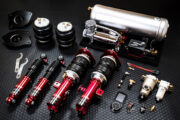Choosing the right vehicle suspension system is crucial for ensuring a comfortable ride, optimal handling, and the overall safety of your vehicle. Whether you’re an off-road enthusiast, a daily commuter, or someone who frequently carries heavy loads, selecting the appropriate suspension system can make a significant difference in your driving experience. Here are our top tips for choosing the right vehicle suspension system.
Understanding Suspension Systems

Before diving into the tips, it’s essential to understand the basics of the vehicle suspension system. The suspension system is a critical component that connects the vehicle to its wheels and allows for relative motion. It includes parts like springs, shock absorbers, struts, control arms, and ball joints. The primary functions of the suspension system are to:
- Absorb shocks from the road: Ensuring that passengers experience a smooth ride even on bumpy surfaces.
- Maintain tire contact with the road: Providing maximum traction and control.
- Support vehicle weight: Helping maintain vehicle balance and stability.
Types of Suspension Systems

There are several types of suspension systems available, each designed for specific driving conditions and vehicle types. The most common types include:
- MacPherson Strut Suspension: Widely used in many modern vehicles, offering a good balance between performance and comfort.
- Double Wishbone Suspension: Known for excellent handling and stability, commonly found in performance and luxury vehicles.
- Multi-Link Suspension: Provides superior ride quality and handling, often used in high-end and sports cars.
- Air Suspension: Allows for adjustable ride height and is popular in luxury and off-road vehicles.
- Leaf Spring Suspension: Traditional design used in trucks and heavy-duty vehicles for load-carrying capabilities.
Tips for Choosing the Right Suspension System

Identify Your Driving Needs
The first step in choosing the right suspension system is to identify your driving needs. Are you driving primarily on highways, city streets, or off-road? Do you prioritize comfort, performance, or load-carrying capacity? For instance, a MacPherson strut suspension might be ideal for daily commuting due to its balance of comfort and performance, while an air suspension could be more suitable for off-road adventures because of its adjustability.
Consider Vehicle Type
Your vehicle type significantly influences the suspension system you should choose. For sedans and compact cars, a MacPherson strut or multi-link suspension is often sufficient. SUVs and trucks, especially those used for towing or carrying heavy loads, may benefit more from a double wishbone or leaf spring suspension due to their enhanced stability and load capacity.
Evaluate Ride Comfort and Handling
Different suspension systems offer varying levels of ride comfort and handling. Test driving vehicles with different suspension types can provide valuable insights. If you prefer a softer ride, an air suspension or multi-link system might be the best choice. For sharper handling and control, especially in performance vehicles, a double wishbone suspension could be more appropriate.
Assess Durability and Maintenance
Some suspension systems require more maintenance than others. For example, air suspensions, while offering great adjustability and comfort, can be more complex and costly to maintain. Leaf spring suspensions are generally durable and require less frequent maintenance but may not provide the same level of ride comfort as other types. Consider the long-term maintenance costs and durability when making your decision.
Think About Load Carrying and Towing Needs
If you frequently carry heavy loads or tow trailers, the suspension system’s load-carrying capacity becomes crucial. Leaf spring suspensions are typically robust and well-suited for heavy-duty applications. For those who need a versatile solution that can handle both everyday driving and occasional heavy loads, adjustable air suspensions can be a great option.
Consider Upgrading Existing Suspension
If you’re not entirely satisfied with your current suspension system, upgrading components such as shock absorbers, springs, or adding sway bars can enhance performance without a complete overhaul. Performance shocks and struts can improve handling, while stiffer springs or sway bars can reduce body roll during cornering.
Consult with Professionals
Consulting with automotive professionals or suspension specialists can provide valuable insights tailored to your specific vehicle and driving needs. They can help you understand the technical aspects and compatibility issues, ensuring you make an informed decision.
Budget Considerations
Suspension systems come in a wide range of prices, from affordable aftermarket kits to high-end performance setups. Establishing a budget before shopping can help narrow down your options and prevent overspending. Remember, while it’s important to consider cost, the cheapest option might not always provide the best performance or durability.
Conclusion

Selecting the right vehicle suspension system is a critical decision that affects your vehicle’s performance, comfort, and safety. By understanding your driving needs, considering your vehicle type, evaluating ride comfort and handling, assessing durability and maintenance, thinking about load carrying and towing needs, and consulting with professionals, you can make an informed choice. Whether you’re upgrading an existing system or choosing a suspension for a new vehicle, taking the time to research and understand your options will ensure you get the best performance and value for your investment.


